Multiplexed Simultaneous High Sensitivity Sensors with High-Order Mode Based on the Integration of Photonic Crystal 1 × 3 Beam Splitter and Three Different Single-Slot PCNCs
Abstract
:1. Introduction
2. The 1 × 3 PhC Beam Splitter Design
3. Single-slot PCNC Design
4. Bandpass Filter Design
5. Multiplexing Sensor Array Design
6. Conclusions
Acknowledgments
Author Contributions
Conflicts of Interest
References
- Armani, A.M.; Vahala, K.J. Heavy water detection using ultra-high-Q microcavities. Opt. Lett. 2006, 31, 1896–1898. [Google Scholar] [CrossRef] [PubMed]
- Lal, S.; Link, S.; Halas, N.J. Nano-optics from sensing to waveguiding. Nat. Photonics 2007, 1, 641–648. [Google Scholar] [CrossRef]
- Armani, A.M.; Kulkarni, R.P.; Fraser, S.E.; Flagan, R.C.; Vahala, K.J. Label-free, single-molecule detection with optical microcavities. Science 2007, 317, 783–787. [Google Scholar] [CrossRef] [PubMed]
- White, I.M.; Fan, X. On the performance quantification of resonant refractive index sensors. Opt. Express 2008, 16, 1020–1028. [Google Scholar] [CrossRef] [PubMed]
- Kita, S.; Nozaki, K.; Baba, T. Refractive index sensing utilizing a cw photonic crystal nanolaser and its array configuration. Opt. Express 2008, 16, 8174–8180. [Google Scholar] [CrossRef] [PubMed]
- Mandal, S.; Erickson, D. Nanoscale optofluidic sensor arrays. Opt. Express 2008, 16, 1623–1631. [Google Scholar] [CrossRef] [PubMed]
- Hanic, S.T.; Rahmani, A.; Steel, M.J.; Sterke, C.M. Comparison of the sensitivity of air and dielectric modes in photonic crystal slab sensors. Opt. Express 2009, 17, 14552–14557. [Google Scholar] [CrossRef]
- Kang, C.; Phare, C.T.; Vlasov, Y.A.; Assefa, S.; Weiss, S.M. Photonic crystal slab sensor with enhanced surface area. Opt. Express 2010, 18, 27930–27937. [Google Scholar] [CrossRef] [PubMed]
- Dahdah, J.; Courjal, N.; Baida, F.I. Analysis of a photonic crystal cavity based on absorbent layer for sensing applications. J. Opt. Soc. Am. B 2010, 27, 305–310. [Google Scholar] [CrossRef]
- Xu, T.; Zhu, N.; Xu, M.Y.-C.; Wosinski, L.; Aitchison, J.S.; Ruda, H.E. Pillar-array based optical sensor. Opt. Express 2010, 18, 5420–5425. [Google Scholar] [CrossRef] [PubMed]
- Caucheteur, C.; Shevchenko, Y.; Shao, L.; Wuilpart, M.; Albert, J. High resolution interrogation of tilted fiber grating SPR sensors from polarization properties measurement. Opt. Express 2011, 19, 1656–1664. [Google Scholar] [CrossRef] [PubMed]
- Yu, Z.F.; Fan, S.H. Extraordinarily high spectral sensitivity in refractive index sensors using multiple optical modes. Opt. Express 2011, 19, 10029–10040. [Google Scholar] [CrossRef] [PubMed]
- Huang, L.; Tian, H.; Zhou, J.; Liu, Q.; Zhang, P.; Ji, Y. Label-free optical sensor by designing a high-Q photonic crystal ring–slot structure. Opt. Commun. 2015, 335, 73–77. [Google Scholar] [CrossRef]
- Sevilla, G.A.C.; Finazzi, V.; Villatoro, J.; Pruneri, V. Photonic crystal fiber sensor array based on modes overlapping. Opt. Express 2011, 19, 7596–7602. [Google Scholar] [CrossRef] [PubMed]
- Grepstad, J.O.; Kaspar, P.; Solgaard, O.; Johansen, I.; Sudbo, A.S. Photonic-crystal membranes for optical detection of single nano-particles, designed for biosensor application. Opt. Express 2012, 20, 7954–7965. [Google Scholar] [CrossRef] [PubMed]
- Wang, Y.; Wang, H.; Xue, Q.; Zheng, W. Photonic crystal self-collimation sensor. Opt. Express 2012, 20, 12111–12118. [Google Scholar] [CrossRef] [PubMed]
- Lai, W.; Chakravarty, S.; Zou, Y.; Guo, Y.; Chen, R.T. Slow light enhanced sensitivity of resonance modes in photonic crystal biosensors. Appl. Phys. Lett. 2013, 102, 041111–041113. [Google Scholar] [CrossRef] [PubMed]
- Fan, F.; Gu, W.; Wang, X.; Chang, S. Real-time quantitative terahertz microfluidic sensing based on photonic crystal pillar array. Appl. Phys. Lett. 2013, 102, 121113–121116. [Google Scholar] [CrossRef]
- Huang, L.; Tian, H.; Zhou, J.; Ji, Y. Design Low Crosstalk Ring-Slot Array Structure for Label-Free Multiplexed Sensing. Sensors 2014, 14, 15658–15668. [Google Scholar] [CrossRef] [PubMed]
- Hachuda, S.; Otsuka, S.; Kita, S.; Isono, T.; Narimatsu, M.; Watanabe, K.; Goshima, Y.; Baba, T. Selective detection of sub-atto-molar Streptavidin in 1013-fold impure sample using photonic crystal nanolaser sensors. Opt. Express 2013, 21, 12815–12821. [Google Scholar] [CrossRef] [PubMed]
- Yang, D.; Tian, H.; Ji, Y.; Quan, Q. Nanoscale photonic crystal sensor arrays on monolithic substrates using side-coupled resonant cavity arrays. Opt. Express 2011, 19, 20023–20034. [Google Scholar] [CrossRef] [PubMed]
- Yang, D.; Tian, H.; Ji, Y. Nanoscale Low Crosstalk Photonic Crystal Integrated Sensor Array. IEEE Photonics J. 2014, 6, 4200107–4200107. [Google Scholar] [CrossRef]
- Zhou, J.; Tian, H.; Yang, D.; Liu, Q.; Huang, L.; Ji, Y. Refractive index sensing utilizing parallel tapered nano-slotted photonic crystal nano-beam cavities. J. Opt. Soc. Am. B 2014, 31, 1746–1752. [Google Scholar] [CrossRef]
- Zhou, J.; Tian, H.; Yang, D.; Liu, Q.; Ji, Y. Integration of high transmittance photonic crystal H2 nanocavity and broadband W1 waveguide for biosensing applications based on Silicon-on-Insulator substrate. Opt. Commun. 2014, 330, 175–183. [Google Scholar] [CrossRef]
- Falco, A.D.; O’Faolain, L.; Krauss, T.F. Chemical sensing in slotted photonic crystal heterostructure cavities. Appl. Phys. Lett. 2009, 94, 063503–063505. [Google Scholar] [CrossRef]
- Jágerská, J.; Zhang, H.; Diao, Z.; Thomas, N.L.; Houdré, R. Refractive index sensing with an air-slot photonic crystal nanocavity. Opt. Lett. 2010, 35, 2523–2525. [Google Scholar] [CrossRef] [PubMed]
- Caër, C.; Serna-Otálvaro, S.F.; Zhang, W.; Roux, X.L.; Cassan, E. Liquid sensor based on high-Q slot photonic crystal cavity in silicon-on-insulator configuration. Opt. Lett. 2014, 39, 5792–5794. [Google Scholar] [CrossRef] [PubMed]
- Zou, Y.; Chakravarty, S.; Zhu, L.; Chen, R.T. The role of group index engineering in series-connected photonic crystal microcavities for high density sensor microarrays. Appl. Phys. Lett. 2014, 104, 141103. [Google Scholar] [CrossRef] [PubMed]
- Yan, H.; Zou, Y.; Chakravarty, S.; Yang, C.; Wang, Z.; Tang, N.; Fan, D.; Chen, R.T. Silicon on-chip bandpass filters for the multiplexing of high sensitivity photonic crystal microcavity biosensors. Appl. Phys. Lett. 2015, 106, 121103. [Google Scholar] [CrossRef] [PubMed]
- Chen, J.H.; Huang, Y.T.; Yang, Y.L.; Lu, M.F. Design, Fabrication, and Characterization of Si-Based ARROW-B Photonic Crystal Sharp-Bend Waveguides and Power Splitters. J. Lightwave Technol. 2012, 30, 2345–2351. [Google Scholar] [CrossRef]
- Yang, D.; Tian, H.; Ji, Y. High-bandwidth and low-loss photonic crystal power-splitter with parallel output based on the integration of Y-junction and waveguide bends. Opt. Commun. 2012, 285, 3752–3757. [Google Scholar] [CrossRef]
- Jensen, J.S.; Sigmund, O. Topology optimization of photonic crystal structures: A high-bandwidth low-loss T-junction waveguide. J. Opt. Soc. Am. B 2005, 22, 1191–1196. [Google Scholar] [CrossRef]
- Fan, S.H.; Johnson, S.G.; Joannopoulos, J.D.; Manolatou, C.; Haus, H.A. Loss-induced on/off switching in a channel add/drop filter. Phys. Rev. B 2001, 64, 245302. [Google Scholar] [CrossRef]
- Zheng, W.; Xing, M.; Ren, G.; Johnson, S.G.; Zhou, W.; Chen, W.; Chen, L. Integration of a photonic crystal polarization beam splitter and waveguide bend. Opt. Express 2009, 17, 8657–8668. [Google Scholar] [CrossRef] [PubMed]
- Thorhauge, M.; Frandsen, L.H.; Borel, P.I. Efficient photonic crystal directional couplers. Opt. Lett. 2003, 28, 1525–1527. [Google Scholar] [CrossRef] [PubMed]
- Zhou, J.; Tian, H.; Yang, D.; Liu, Q.; Huang, L.; Ji, Y. Low-loss, efficient, wide-angle 1 × 4 power splitter at ~1.55 μm wavelengths for four play applications built with a monolithic photonic crystal slab. Appl. Opt. 2014, 53, 8012–8019. [Google Scholar] [CrossRef] [PubMed]
- Tee, D.C.; Kambayashi, T.; Sandoghchi, S.R.; Tamchek, N.; Adikan, F.R.M. Efficient, Wide Angle, Structure Tuned 1 × 3 Photonic Crystal Power Splitter at 1550 nm for Triple Play Applications. J. Lightwave Technol. 2012, 30, 2818–2823. [Google Scholar]
- Lumerical Solutions, Inc. Available online: http://www.lumerical.com (accessed on 12 June 2015).
- Quan, Q.; Lončar, M. Deterministic design of wavelength scale, ultra-high Q photonic crystal nanobeam cavities. Opt. Express 2011, 19, 18529–18542. [Google Scholar] [CrossRef] [PubMed]
- Wang, X.; Shi, W.; Yun, H.; Grist, S.; Jaeger, N.A.F.; Chrostowski, L. Narrow-band waveguide Bragg gratings on SOI wafers with CMOS-compatible fabrication process. Opt. Express 2012, 20, 15547–15558. [Google Scholar] [CrossRef] [PubMed]
- Bogaerts, W.; Selvaraja, S.K.; Dumon, P.; Brouckaert, J.; de Vos, K.; van Thourhout, D.; Baets, R. Silicon-on-insulator spectral filters fabricated with CMOS technology. IEEE J. Sel. Top. Quantum Electron. 2010, 16, 33–44. [Google Scholar] [CrossRef]
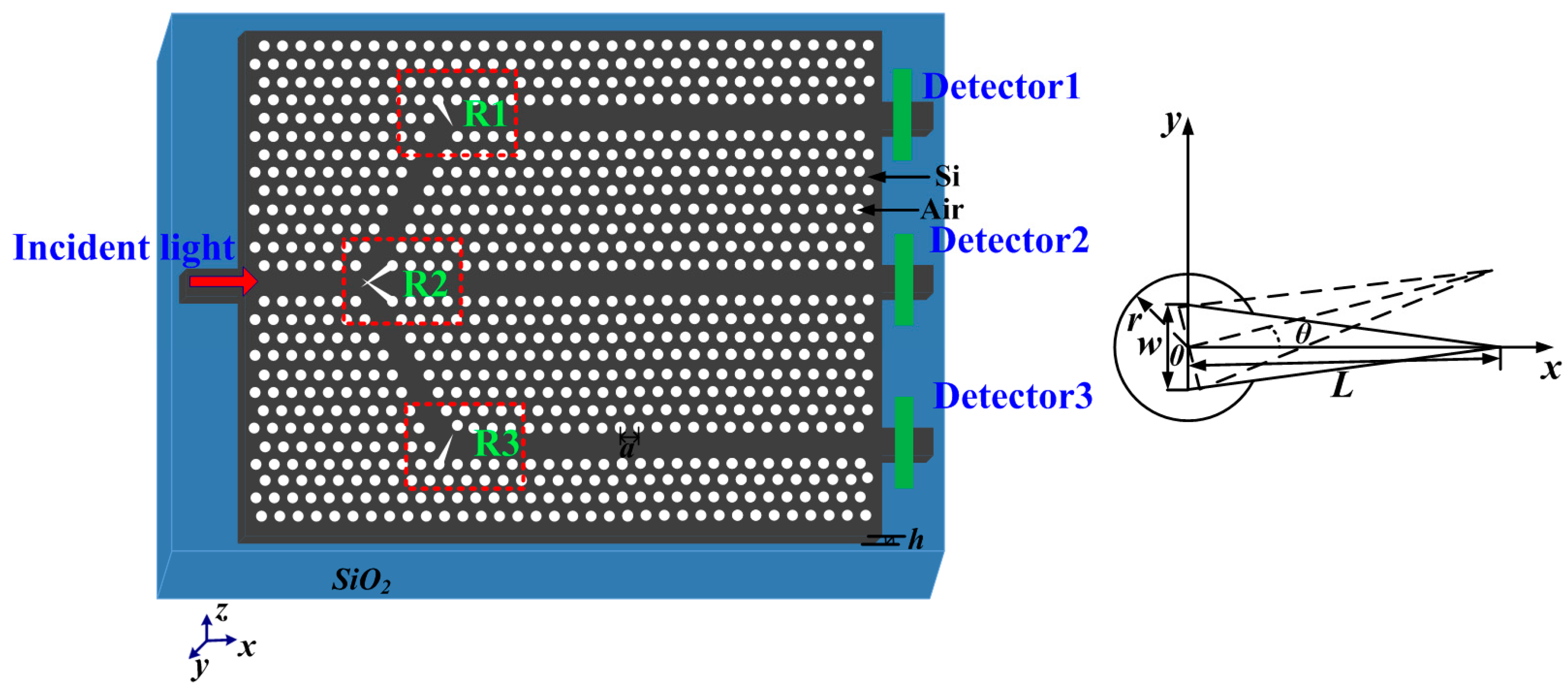


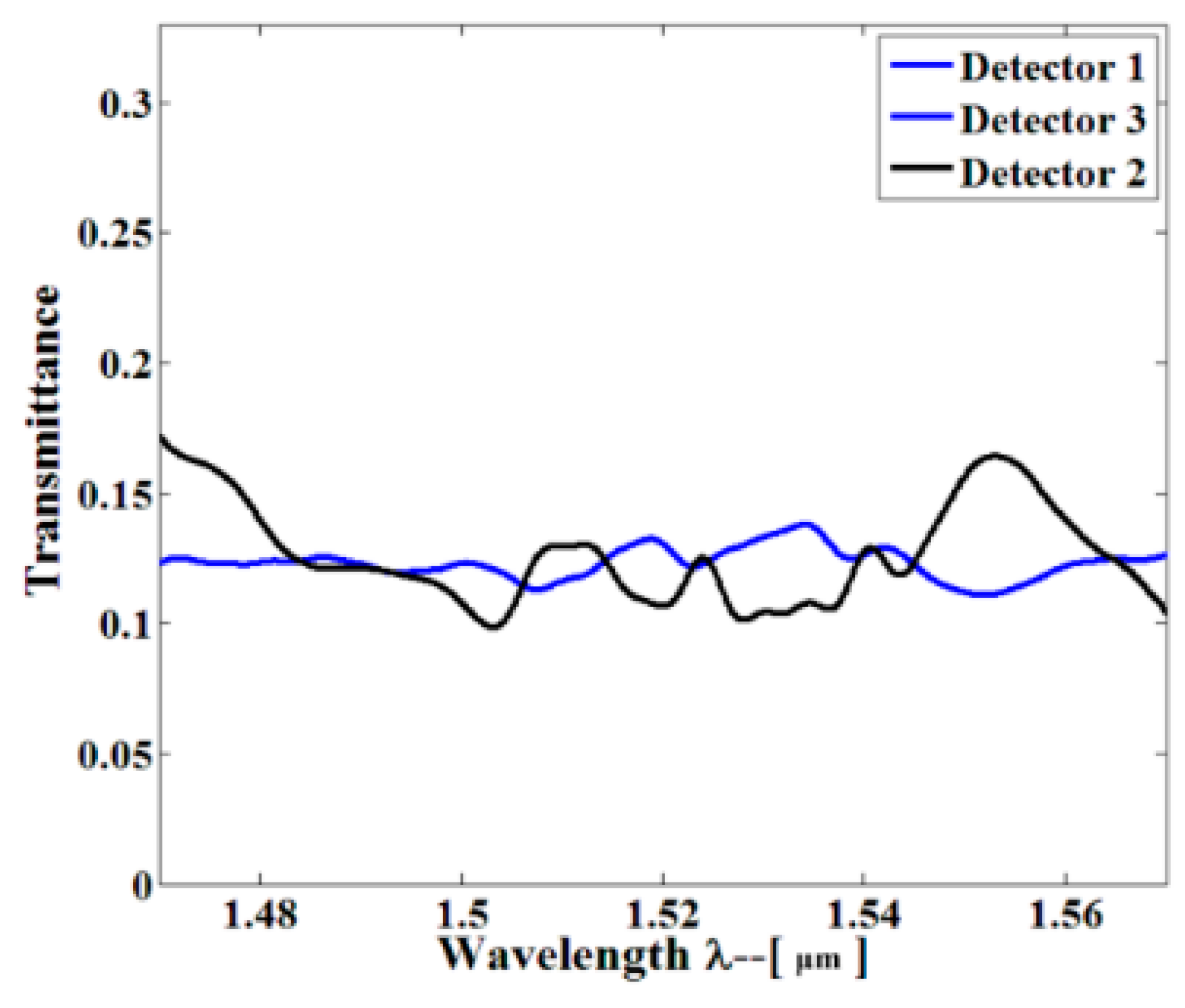

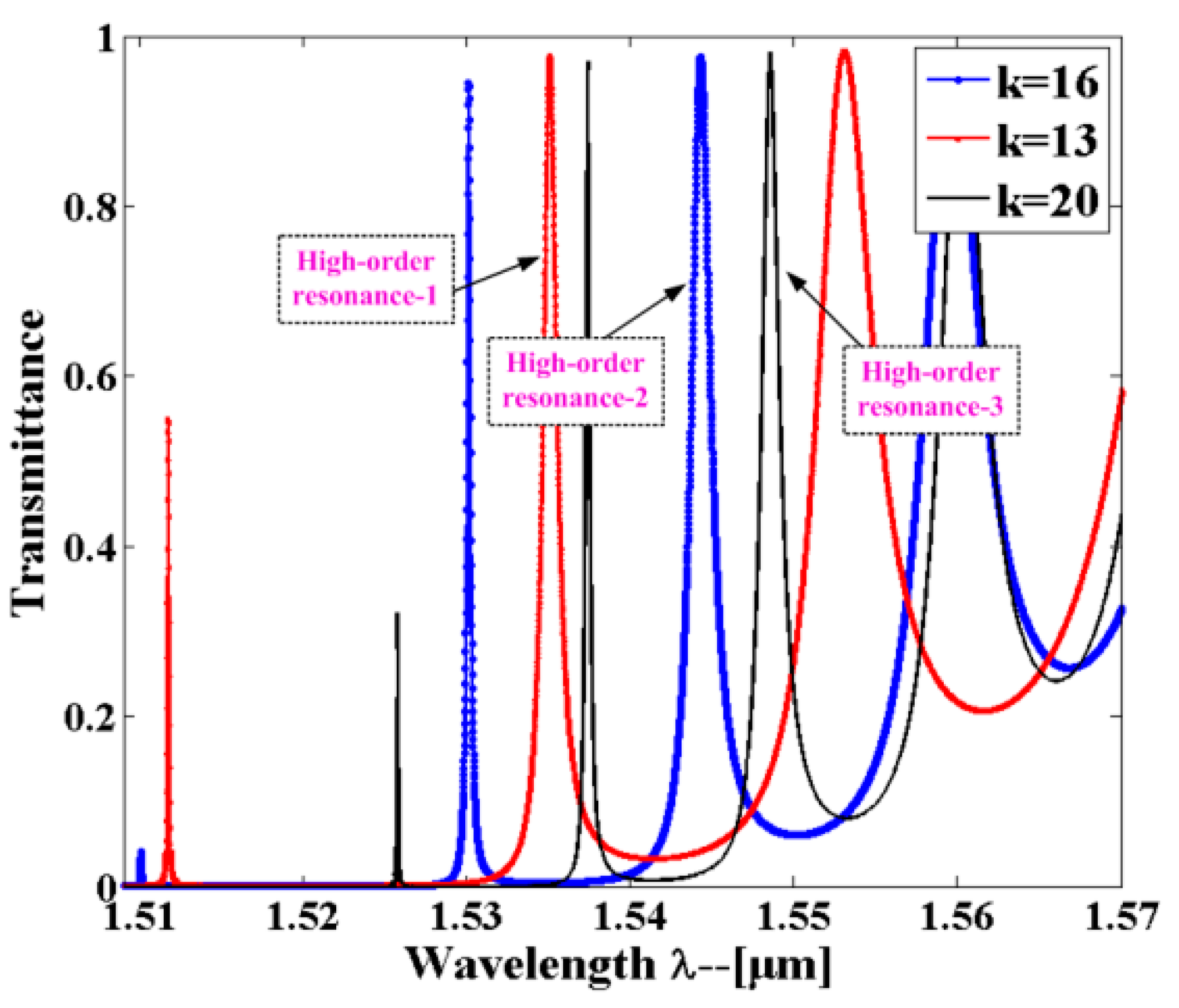
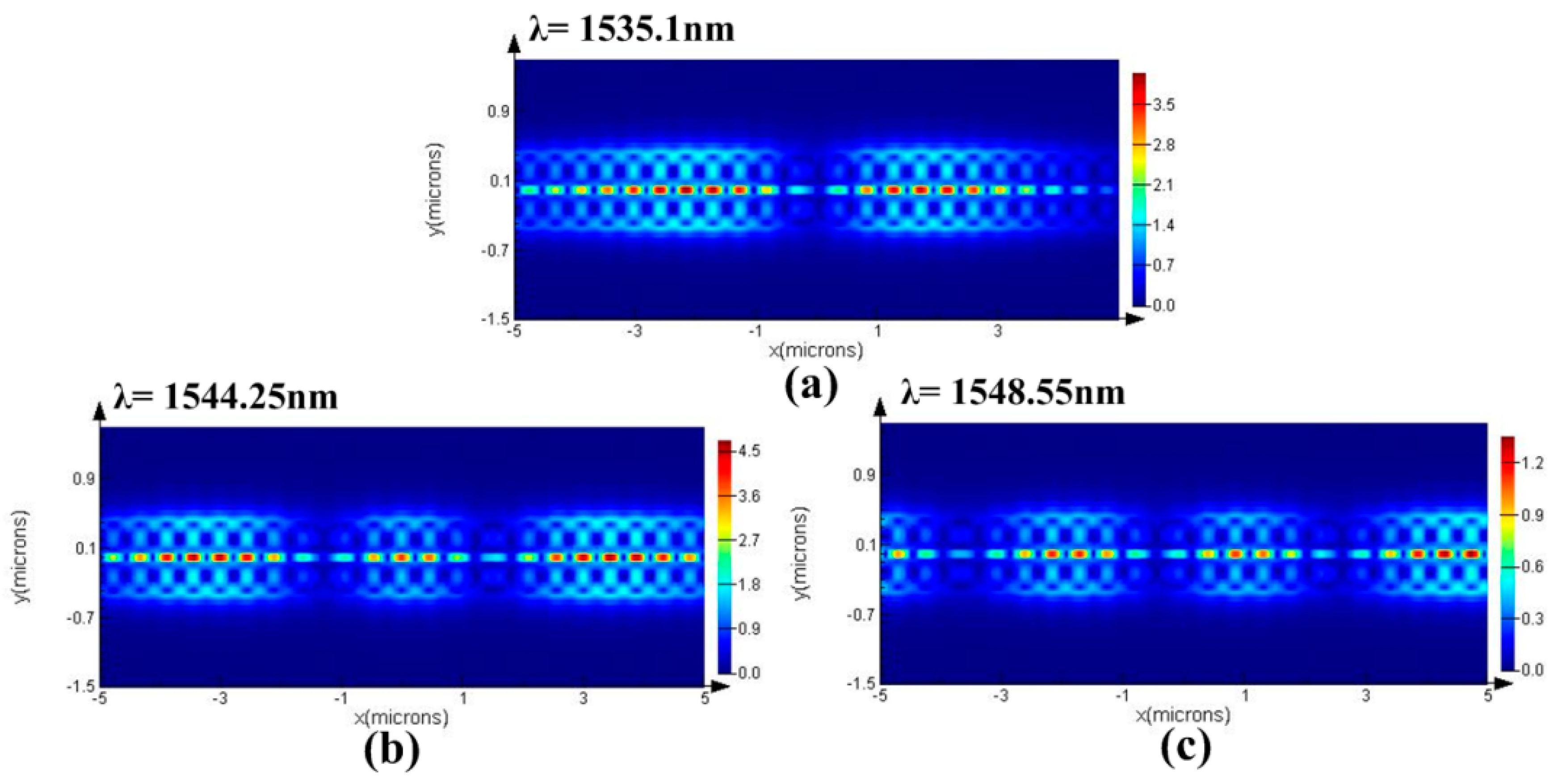
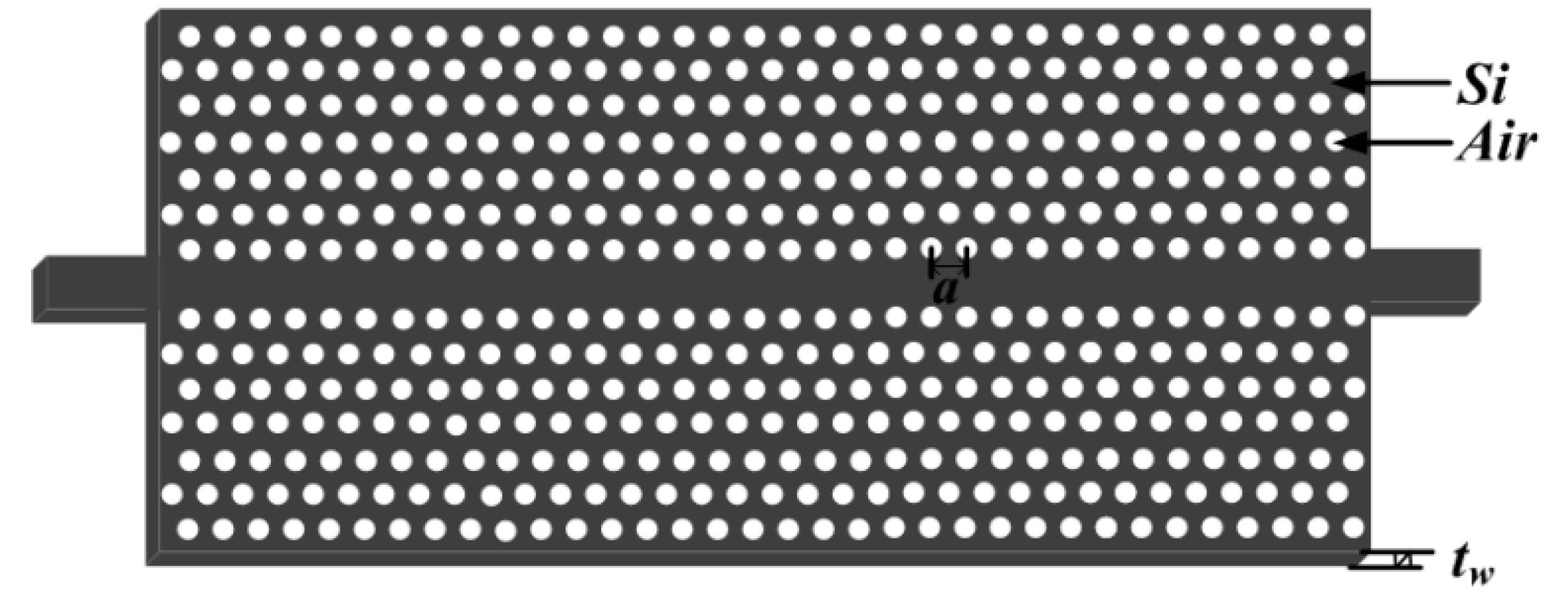

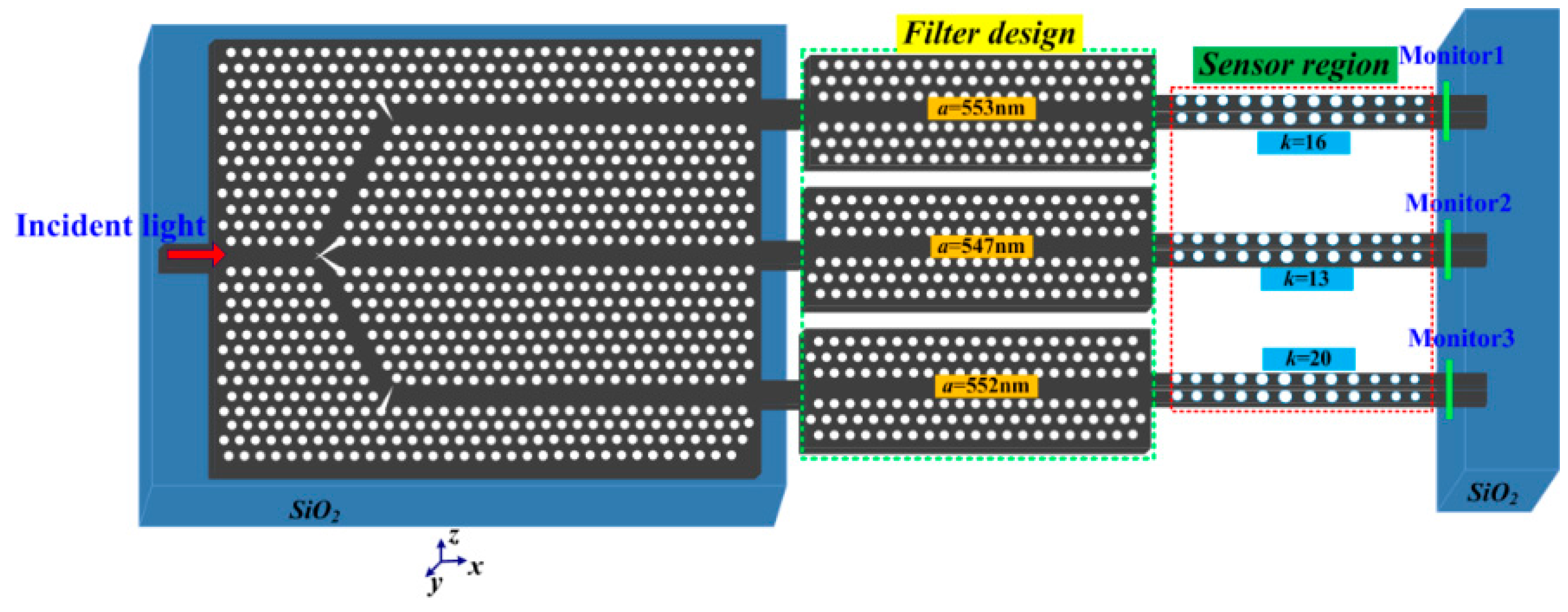

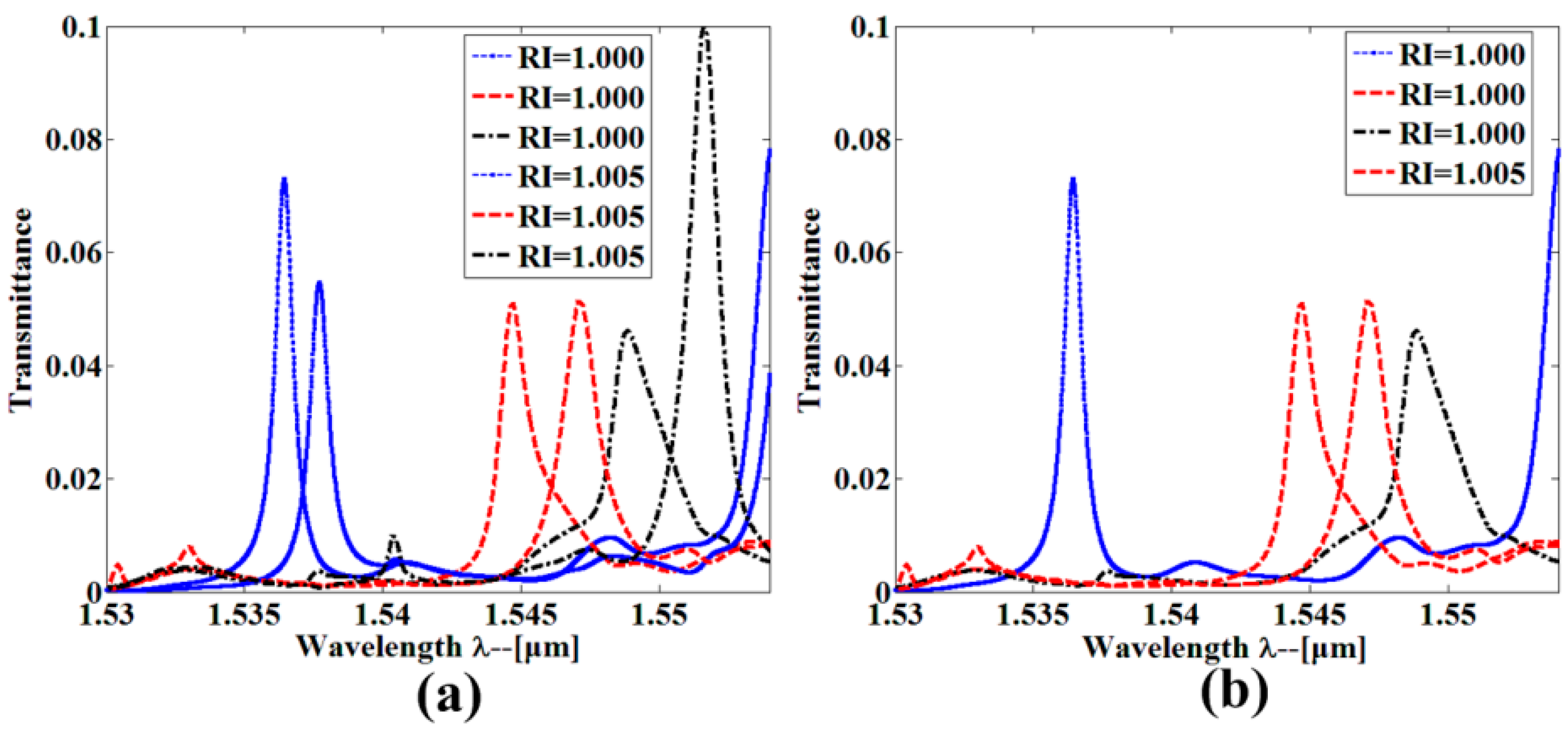
© 2016 by the authors; licensee MDPI, Basel, Switzerland. This article is an open access article distributed under the terms and conditions of the Creative Commons Attribution (CC-BY) license (http://creativecommons.org/licenses/by/4.0/).
Share and Cite
Zhou, J.; Huang, L.; Fu, Z.; Sun, F.; Tian, H. Multiplexed Simultaneous High Sensitivity Sensors with High-Order Mode Based on the Integration of Photonic Crystal 1 × 3 Beam Splitter and Three Different Single-Slot PCNCs. Sensors 2016, 16, 1050. https://doi.org/10.3390/s16071050
Zhou J, Huang L, Fu Z, Sun F, Tian H. Multiplexed Simultaneous High Sensitivity Sensors with High-Order Mode Based on the Integration of Photonic Crystal 1 × 3 Beam Splitter and Three Different Single-Slot PCNCs. Sensors. 2016; 16(7):1050. https://doi.org/10.3390/s16071050
Chicago/Turabian StyleZhou, Jian, Lijun Huang, Zhongyuan Fu, Fujun Sun, and Huiping Tian. 2016. "Multiplexed Simultaneous High Sensitivity Sensors with High-Order Mode Based on the Integration of Photonic Crystal 1 × 3 Beam Splitter and Three Different Single-Slot PCNCs" Sensors 16, no. 7: 1050. https://doi.org/10.3390/s16071050




